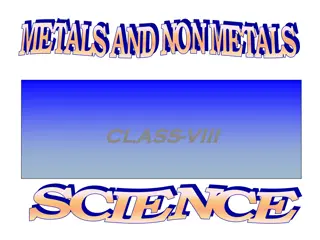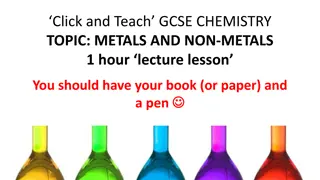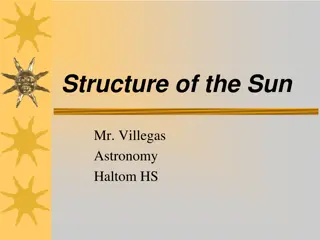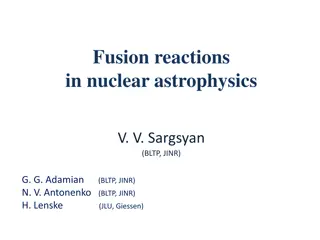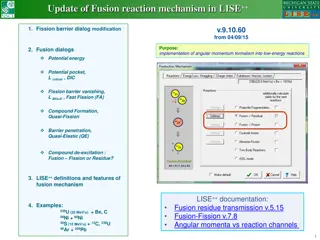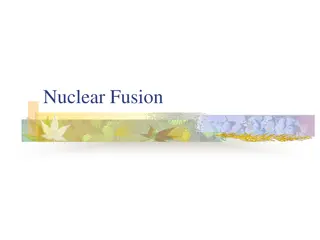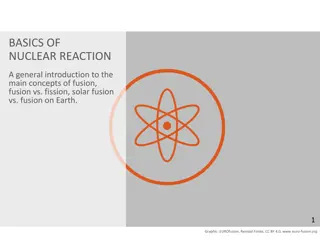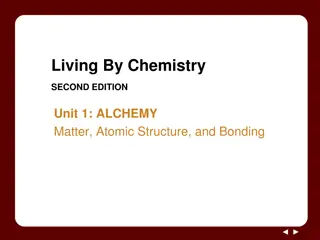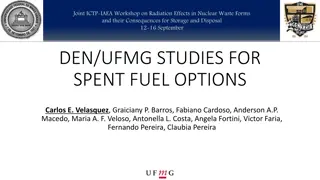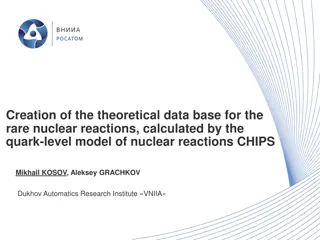Cold Fusion Research: Insights and Innovations in Highly Hydrided Metals and Low-Energy Nuclear Reactions
This presentation explores ongoing efforts in cold fusion research, highlighting the lack of evidence for its effects but discussing new insights gained in highly hydrided metals and low-energy nuclear reactions. The potential for further exploration in this underexplored parameter space is emphasized, offering opportunities for groundbreaking scientific discoveries. Despite the initial dismissal of cold fusion claims, recent advancements suggest a promising future in the field of energy research.
Download Presentation

Please find below an Image/Link to download the presentation.
The content on the website is provided AS IS for your information and personal use only. It may not be sold, licensed, or shared on other websites without obtaining consent from the author. Download presentation by click this link. If you encounter any issues during the download, it is possible that the publisher has removed the file from their server.
E N D
Presentation Transcript
Can Cold Fusion be kept in Cold Storage Anylonger In this presentation one effort is described, which has yet to yield any evidence of such an effect. Nonetheless, a by- product of the investigations has been to provide new insights into highly hydrided metals and low-energy nuclear reactions, and it is contended that there remains much interesting science to be done in this underexplored parameter space. Reference: Curtis P Berlinguette et al, Nature 570, (June 2019) 45 51
In this presentation one effort is described, which has yet to yield any evidence of such an effect. Nonetheless, a by-product of the investigations has been to provide new insights into highly hydrided metals and low-energy nuclear reactions, and it is contended that there remains much interesting science to be done in this underexplored parameter space.
An extraordinary scientific claim was announced on 23 March 1989: the thermal energy produced during electrolysis of heavy water using a palladium cathode exceeded the energy accounted for by the input electricity and all known chemical processes. This potentially novel nuclear effect became known as cold fusion . It offered the prospect of clean, abundant, inexpensive energy, and therefore generated global media attention. But the generation of anomalous heat or nuclear fusion products during electrolysis was not appropriately validated, and the claims were swiftly dismissed by the scientific community. In November 1989, a panel convened by the US Department of Energy recommended against any special funding for the investigation of phenomena attributed to cold fusion. In the parlance of police procedurals, the case went cold.
Many modern day RS other scientific personnel may not have heard about it disqualified in academic research since 1989 light ion fusion agrees with conservation of energy 2015 team 30 graduate students PDFs and scientific staff Two years of research keep low profile collaboration Guiding principles transparency stringent peer review
Relevant physical material conditions credibly realized An open question Then there must be good technical reasons why they have not struggled to detect anomalous effects reliably and reproducibly Other areas Absorption of hydrogen into Pd Metal solute interactions affect the properties relevant to energy storage, catalysis, sensing. New materials new experimental techniques Of highly hydride metals and low energy nuclear reactions Broader scientific community even if the discovery of cold fusion at high enough rates for energy applications does not materialize Highly hydride metals Calorimetry Low energy nuclear reactions
A Historical view 1956 Muon catalyzed fusion 1989 March 23 Martin Fleishmann and Stanley Pons measure heat involved in electrolysis using Pd cathodes immersed in lithiated heavy water (Fig1) heat balance current density and electrode area more heat led to nuclear mechanism detection of neutrons as evidence
Scepticism - coulomb barrier probability of fusion drops exponentially as particle energy is reduced. 2 keV in the centre frame or more than 20 million kelvin Rates predicted and observed low value to electron screening effects possibly promoting tunneling through the coulomb barrier Branching ratios (Fig1) D-D path way predominate- host lattice as sink Momentum conservation rule violated in branching routes
So far, efforts to independently replicate claims of anomalous heat and fusion reaction products have not yielded sufficient evidence to support the existence of cold fusion. In 2004, a second review by the US Department of Energy recommended two areas for additional research to resolve some of the controversies in the field: the material science aspects of deuterated metals using modern characterization techniques; and the study of particles reportedly emitted from deuterated foils using state-of-the-art apparatus and methods. Few academic laboratories took up this charge. This programme sought to remedy that situation
Considerable literature http://lenr-canr.org (1) the claim that metal electrodes loaded with extraordinary amounts of hydrogen are a necessary precursor to cold fusion; (2) the claim that metallic powders heated in a hydrogen environment produce excess heat; and (3) the claim that pulsed plasma discharges produce tritium and other anomalous nuclear signatures require experiments at high Pr, temp and potentials academic understanding and cold fusion claims
Michael McKubre and colleagues at SRI International (California, USA) conducted one of the largest studies of cold fusion. In the early 1990s, they performed dozens of Fleischmann Pons type electrolysis experiments and claimed to observe excess heat only when the palladium cathode was loaded with hydrogen beyond a threshold of PdHx where x > 0.875 ( hydrogen represents hydrogen, deuterium, protons, deuterons, or hydride.) Notwithstanding the ongoing debate about whether high loading is important per se, or whether it induces important secondary phenomena (structural defects), that understanding how to create, characterize and sustain highly hydrided metals would be a priority of this program
Most FleischmannPons type experiments use palladium cathodes loaded with deuterium, so the focus on the PdHx materials. Palladium, one of the few elements that readily absorb hydrogen, forms PdHx where x 0.7 at room temperature and 1 atm of hydrogen pressure. However, it is challenging to produce and characterize stoichiometries of PdHx where x > 0.7 (Fig. 2). The absorption of hydrogen by palladium successively forms two distinct phases: a solid solution -phase at lower hydrogen concentrations, and a lattice-expanded -phase at higher hydrogen concentrations. For both phases, hydrogen occupies octahedral interstices in the face-centred cubic palladium crystal lattice. In the -phase, the composition can conceivably form a rock salt structure with a stoichiometry of PdH 1.0. However, at ambient temperature and pressure, the -phase is limited to a stoichiometry of PdH0.7 (Fig. 2) ; further absorption of hydrogen into -PdHx requires an exponential increase in hydrogen pressure. There are very few studies that provide convincing evidence for a bulk loading of x > 0.875 in PdHx and even fewer where x 1. In the case where x = 1.33 was observed, the lattice underwent a phase change under extreme conditions (973 K and about 50 katm of mechanical pressure) to form a metastable superabundant vacancy phase, as measured by in situ XRD
It was considered a range of techniques to produce and sustain highly hydrided palladium. Electrochemistry emerged as our method of choice because a modest applied potential produces high hydrogen fugacity, thereby enabling high hydrogen loading without high pressure hydrogen gas. Merely 120 mV in overpotential produces the thermodynamic equivalent of approximately 100 atm of pressure, but competing hydrogen desorption reactions still make it difficult to reach exceptionally high hydrogen loading levels. The numerous types of palladium electrodes we tested in aqueous media all yielded values of x <0.875 in PdHx. Reproducible only x =0.81 at -1V. This cell enabled the use of X-ray to measure the loading levels by measuring the lattice expansion during absorption.
Characterizing hydrogen concentrations in palladium is also challenging. Loading palladium electrodes with interstitial hydrogen causes the metallic lattice to expand, the electrical impedance to change and the mass to increase. It was found that in situ X-ray diffraction, which measures lattice parameter changes, and stripping coulometry, which measures charge passed during hydrogen desorption, to be the most accurate ways of characterizing PdHx stoichiometry in electrochemical environments. It discovered, and corrected, errors in previously used lattice expansion calibrations that would otherwise lead to an overestimation of x. In the experiments, four terminal sensing, which measures electrical impedance to infer PdHx stoichiometry, disagreed with X-ray diffraction on the same samples. Mechanical stresses and irreversible plastic deformation caused by lattice expansion affects the impedance of the electrodes independently of hydrogen loading. Finally, to track gas-phase loading of hydrogen in thin metal films, we designed a quartz microbalance that measures mass increase as hydrogen ions are absorbed. For accurate measurements of hydrogen loading with this technique, additional factors such as stress-induced film curvature during gas absorption must be included. The experience affirms that the materials science aspects of deuterated metals merit further study, as concluded in the 2004 US Department of Energy review. If loading metals with exceptionally high concentrations of hydrogen is indeed a necessary precursor for cold fusion, then more work is required to produce stable samples of PdHx where x 0.875 to comprehensively evaluate these claims. It also remain intrigued by what properties could arise from PdHx samples where x 1.
Calorimetry under extreme conditions Since the early 1990s, researchers in Italy and elsewhere have reported that compositions of certain metallic powders produce excess heat when heated under hydrogen gas. To assess these claims, all of the ways energy can enter, leave, or be stored in an experiment operating at high temperature and high pressure have to be accounted for. Learning how to perform calorimetry under extreme conditions became another . Prototyped several calorimeter designs to enable these studies. This experience acquainted with many modes of apparatus failure, some quite subtle, induced by the high-temperature, high-pressure environments and the harsh metal/alkali/hydrogen samples required for these experiments (Fig. 3) . It was settled on a calorimeter capable of operating up to 1,200 C and 33 atm with less than 2% measurement uncertainty. The design objective was to be able to resolve 10% excess heat to a high degree of confidence. Stated more precisely, it was aspired to measure a coefficient of performance (COP, defined as the ratio of energy going out of and into the calorimeter) > 1.09 with 0.98 statistical power, which required replicating each experiment in four identical calorimeters, in accordance with analysis-of- variance principles. (Here, 0.98 statistical power indicates a 98% probability of correctly identifying an effect if there is one)
Over the course of 16 months, it was evaluated contemporary claims of more than 10% excess heat production involving samples of nickel powder and lithium aluminium hydride (LiAlH4). Also tested the independent variables of temperature, pressure, sample composition, particle size, surface treatment, and others. To verify the stability of our calorimeters, control experiments were conducted before and after each sample run. Developed a system identification framework to facilitate modelling the time- dependent heat flows and energy storage processes particular to each calorimetry experiment. However, none of the 420 samples evaluated provided evidence of excess heat; the COPs measured in our experiments were consistently unity ( 0.0825 ); It was conceded that we might not have tested all of the experimental conditions required to initiate excess heat as claimed, and so we have made our calorimeter design and analytical tools publicly available for those seeking to evaluate this parameter space further. The studies confirm that conducting calorimetry under extreme conditions is challenging, but not intractable. While we have detected no convincing evidence of excess heat so far, our experience with a number of calorimetry systems gives us confidence that we will know if we see it
Low-energy nuclear reactions Thomas Claytor and colleagues at Los Alamos National Laboratory (New Mexico, USA) reported the production of tritium in low energy benchtop experiments in the mid-1990s. They used a pulsed plasma discharge in a deuterium gas environment to drive deuterons into a palladium cathode. Evaluating this claim requires measuring fusion by-products (for example, neutrons, protons, tritons, 3He, 4He, or -rays) as a function of energy in a challenging regime. To incorporate nuclear diagnostics into programme because nuclear signatures, which integrate over the duration of the experiment and provide insight into reaction mechanisms, provide a useful complement to thermal analysis. The 2004 US Department of Energy review also recommended the study of nuclear particles in cold fusion experiments. Developed an apparatus to bombard palladium targets with pulsed plasmas of deuterium ions that is capable of producing more flux than the ion beams more commonly used for nuclear astrophysical studies of fusion reactions at low energies (Fig. 4). Initial experiments consisted of a palladium wire (cathode) surrounded by a stainless steel cage (anode) housed in a vacuum chamber containing deuterium gas (D2 ) at about 1 torr. Pulses of electricity (20- s pulse width, 50-Hz repetition rate, 1-A peak ion current) ionized the D2 and drove D+ ions into the palladium wire. External 3He-based proportional counters and organic scintillators coupled to photomultiplier tubes were used to detect neutrons; an internal silicon diode was used to detect
Early results from these ongoing studies have confirmed that one can produce and detect neutrons from D D fusion at discharge voltages corresponding to 1.2-keV ion energies in the centre-of-mass frame. The dose rate of deuterium ions in these experiments (1 Acm 2 ) is much higher than in ion-beam experiments (0.01 0.1Acm 2 ). Ex situ measurements of the palladium wire targets after prolonged irradiation (hours to weeks, with total fluences of about 1021 D+ cm-2 ) using scintillation counters have provided no evidence so far of enhanced tritium production. Studying fusion physics at low reaction energies is challenging because the rates of fusion drop exponentially with energy, and quickly approach unmeasurably low levels . Accordingly, experimental data for light-ion fusion reactions have large error bars at low energies, and data below 2 keV in the centre-of-mass frame are sparse (Fig. 5) The next phase of our plasma discharge experiments will build on our experience of creating and characterizing highly hydrided metal targets. Targets with better controlled materials properties open the possibility of conducting better defined ion-beam and plasma experiments at colder temperatures. Are enthused by the possibility of obtaining reaction cross-section and S-factor data in the grey shaded region of Fig. 5 that could advance the frontier of low-energy fusion Physics.
Call to action Fusion stands out as a mechanism with enormous potential to affect how we generate energy. This opportunity has already mobilized a 25 billion dollar international investment to construct ITER. Simultaneous research into alternative forms of fusion, including cold fusion, might present solutions that require shorter timelines or less extensive infrastructure. A reasonable criticism of the effort may be Why pursue cold fusion when it has not been proven to exist? . One response is that evaluating cold fusion led the program to study materials and phenomena that otherwise might not have considered. while setting out looking for cold fusion, and instead benefited contemporary research topics in unexpected ways. A more direct response to this question, and the underlying motivation of the effort, is that our society is in urgent need of a clean energy breakthrough. Finding breakthroughs requires risk taking, and one can contend that revisiting cold fusion is a risk worth taking. It is hoped the journey will inspire others to produce and contribute data in this intriguing parameter space. This is not an all-or-nothing endeavour. Even if we do not find a transformative energy source, this exploration of matter far from equilibrium is likely to have a substantial impact on future energy technologies.




